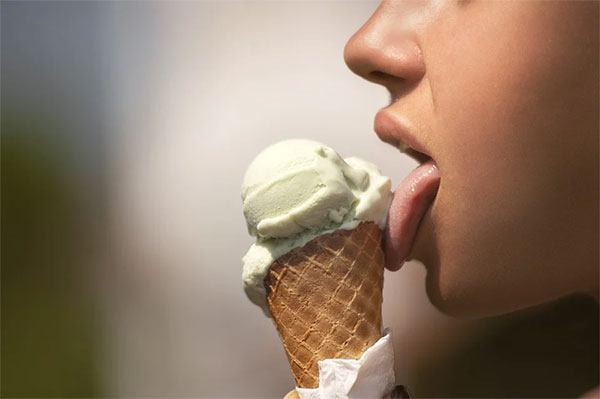
Everyone loves ice cream and the wide variety of flavors it is available in now, but there are many out there that turn their backs on it.
Why? Because being so thirsty afterward seems pointless, why indulge in something so delicious if afterward, you are so thirsty you need to drink and wash away the taste.
Why does ice cream make us so thirsty?
What exactly is Ice Cream?
It may seem obvious that ice cream includes sugar, but it is also made of milk and cream, occasionally mixed with other ingredients for flavor and substance.
Ice cream has been very loved for many decades but didn’t become commonplace until the invention of freezing and refrigeration.
As it becomes more popular and widespread it led to a plethora of colors and flavors, turning it into a major industry, introducing brands such as Ben & Jerry’s, Hӓagen-Dazs, Blue Bell, and more.
They introduced new flavors starting at the simple, vanilla, chocolate, and strawberry options, but building into new flavors such as; coffee, lemon, apple, peanut butter, and many, many more.
You can also get more types now too as it has built into a more inventive industry, there are types of frozen custard, frozen yogurts, and non-dairy vegan options that use plant based kinds of milk, such as oat, soy, or coconut.
In the USA, ice cream is made from 10% to 16% milk fat. Ice creams made from higher fat content are usually smoother because they have fewer ice crystals and therefore less water too.
If an ice cream has a lower milk fat content than 10% it is considered low-fat or sometimes may be labeled as ice milk. These usually have more ice crystals and hence, more water too.
How is Ice Cream made?
While it can be easy to assume how ice cream is made, as it is not a difficult thing to imagine, mixing up some ingredients into a creamy solution that tastes wonderful.
You may have even attempted to make some in your own food blender at home. But it probably didn’t turn out quite as you would see in an ice cream parlor or from a superstore freezer.
You may note one curiosity about ice cream, if you stick something in the freezer, it will usually freeze solid and become hard, but this doesn’t happen with ice cream.
Why? What is it about ice cream that resists freezing temperatures and keeps it delicious and creamy while everything else is as solid as a brick?
Special techniques are used to make sure that the ice cream creates smaller ice crystals and incorporates air to create the soft texture we all love.
The non-stop, constant churning of the ice cream insure that large ice crystals do not form inside the mixture. This stops any complete solidification from cold temperatures.
This is also done to introduce air which will make it foamy to the touch, which will soften it even more, as a rule of thumb, the softer and creamier your ice cream is the more air that is in it.
It may shock you to learn that there is also salt in your ice cream which is introduced to lower the melting point. It does this by drawing the heat out of the ice cream mixing process faster which can cause it to freeze at a much faster rate.
Doing so fast enough produces small ice crystals and makes the final product much softer. The salt mixed with the ice will never touch the actual ice cream though, so it does not affect the sodium content of the food.
This salt-filled ice is packed around the ice cream chamber that contains the ice cream itself. So the ice cream is inside and the salt is outside.
This process can also be done using liquid nitrogen or dry ice, as they are also very capable of fast producing the freezing temperatures required.
So, why does Ice Cream make me really thirsty?
Ice cream will make you thirsty for the same reason that chocolate, sugary candies, and a glass of wine will.
It is much like how cookies are usually eaten with a glass of milk or a cup of coffee, or how you will have candies served with a drink.
When you eat sweet things that have high sugar content, the sugar will enter your bloodstream.
These sugar particles that you ingest from these foods or drinks absorb the water out of your blood and your body’s cells, which will dehydrate you and deplete your supplies.
As a result of this, your brain kicks into action and will send signals to the rest of your body that your water levels are lower than before and you need to rehydrate.
In some sense, your brain is like your body’s manager, it keeps track of everything going on, and when you are low on stocks it orders more in.
That is exactly what happens here, your brain recognizes that this overload in sugar particles is stealing your bodies’ cells water and a part of your brain called the hypothalamus triggers you to feel thirsty so you rehydrate. Replenishing what water you lost to the sugar.
A similar thing will happen in any high-sugar content foods, sugary cakes, chocolate, a cup of hot cocoa may make you thirsty too, as will a glass of wine.
The thirst is triggered by the sugar. It is even very possible that an ice cream that has a lower-sugar content may not make you feel as thirsty.
Our advice?
If you want to have some ice cream but hate the thirst, keep a bottle of water with you or maybe give low-sugar ice creams a try and see if you can feel the difference.
